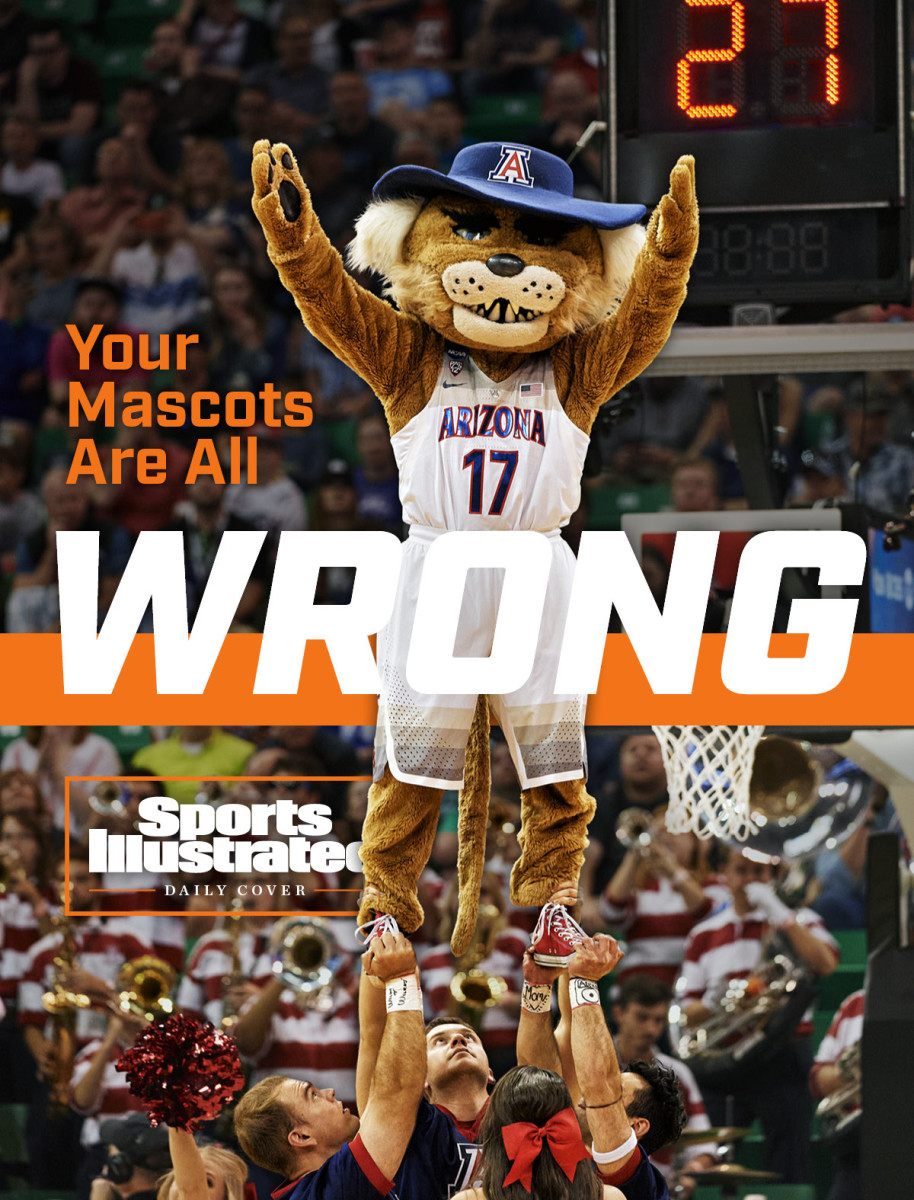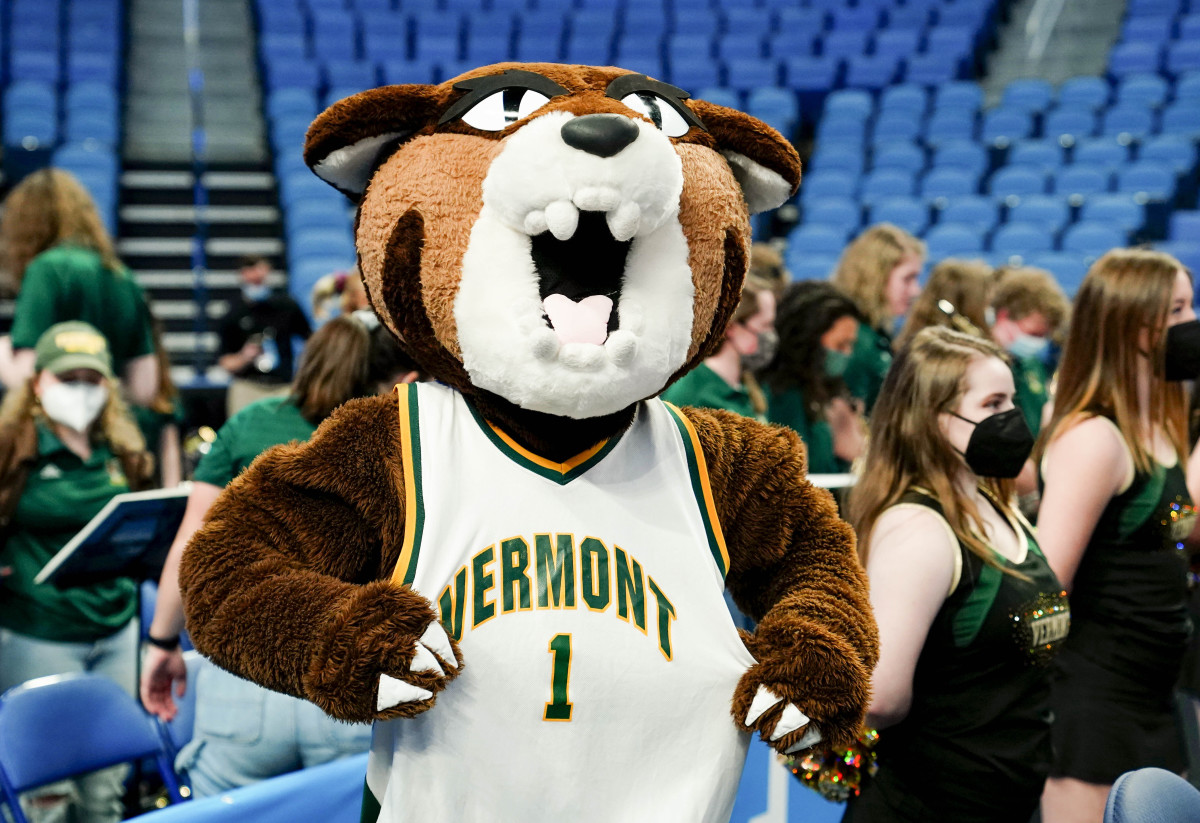Fuzzy Logic
This story was originally published on Mar. 21, 2022. It was included in a year-end list of SI’s best stories of 2022.
Back in 1999, when I was a Ph.D. student at the University of Washington, my then sports-fanatic boyfriend got us tickets to the NCAA tournament’s first-round games in Seattle. I hadn’t really followed college basketball; I’d never filled out a bracket or understood what the “madness” was all about. I’d grown up in more of an NFL house. So, I was just going for the experience, not rooting for any team in particular—which is probably why I became so enthralled with the mascots.
My research at the time was focused on small mammals, like rodents, and so I got super excited when I saw one of the teams playing was Minnesota, nicknamed the Golden Gophers. A college team whose mascot was a rodent! Suddenly, Minnesota was going to be the highlight of my tournament. And at the start of that game, this big, golden furry thing comes marching out, riling up the crowd.
Then it turned around, and I could see its backside. And that’s when the disappointment set in.
I remember screaming: “That’s not a gopher!”

First, Goldy Gopher has a big, floofy tail. But a real gopher has a little nub tail, which is characteristic of subterranean rodents. I thought for a moment that this mascot might actually be a beaver, because its tail is almost flat and paddle-like. But a beaver’s tail isn’t furry; it’s scaly.
I looked at the color pattern on Goldy’s tail and body more carefully, and I thought it might, in fact, be a chipmunk—but a chipmunk has stripes that go down the center of its back and tail. Goldy has stripes on the side. Eventually I became convinced: He’s actually a golden-mantled ground squirrel, which has a fluffy tail and stripes on its sides. The Minnesota Golden-Mantled Ground Squirrels—that has a nice ring to it, right?
The Saskatchewan Roughriders, in the CFL, have a gopher mascot: Gainer the Gopher. He’s an actual gopher. He has a light-colored belly, like a gopher; a short little nub of a tail; and no stripes anywhere. They got it right.
I was so incensed by the biological incorrectness of Minnesota’s Golden Gopher that I wrote a complaint to the school’s athletic director. But I never heard back.
Listen to an audio version of this story on our podcast, Sports Illustrated Weekly.
From that moment on, however, I’ve kept notes on animal mascots that aren’t quite right. Here are some of my favorites:
• O.K., so there are actual wildcats. There are two different species: the European wildcat and the African wildcat. They’re a relatively small cat species—a little stockier build than a domesticated house cat, with slightly longer legs. They’re gently striped, and they have these long, elegant tails. They’re actually quite cute and not particularly fierce. (A fun fact: African wildcats were revered in ancient Egypt, and they were likely old ancestors of all domestic house cats.) But the wildcat mascots? With one exception, they don’t look at all like wildcats.
Arizona has Wilbur and Wilma the Wildcat, a married couple. Wilbur is reddish in color, with a light fringe on his face, and he has no visible tail—all of which would suggest he’s actually a bobcat. Which makes sense; the school did use a live bobcat as its mascot more than 100 years ago. (Wilma, the female of the pair, looks like a hybrid between a puppy and a bear cub. She’s so cartoonish, though. Let’s leave her out of this.)
Northwestern has Willie the Wildcat. He has to be a lynx. He has no stripes, and no tail, which definitely rules out a wildcat. The white fringe on his face—a sideburn-beard kind of thing—is also characteristic of a lynx. His gray color and exceptionally pointy ears seal it: He’s a lynx.
Kansas State’s wildcat, also named Willie, is clearly a mountain lion. He has a very sleek physique; small ears that point backwards; and short, uniformly colored hair, except for white cheeks—all characteristic of a mountain lion. So, mountain lion, right? Maybe. Mountain lions are not characteristically gray.
Kentucky’s wildcat is also almost certainly a mountain lion. He’s light brown, with a white snout and cheeks. Mountain lion. Except! Like Kansas State’s mascot, he doesn’t seem to have a tail. That’s not at all mountain-lion-like. Or wildcat-like.
Of all the wildcat mascots I’ve seen, only Villanova’s Will D. Cat may actually qualify as a biologically correct wildcat. He has a long tail and carnivorous teeth, and he even has stripes on his head. Out of all the loads of wildcat mascots out there, Villanova’s is the most wildcat-like, in this expert’s opinion.
• Vermont’s mascot, the Catamount, is a name thought to be derived from Old English, for “cat of the mountain.” A catamount most often refers to a cougar found in the eastern U.S., and that is thought to have gone extinct in the early 20th century. But some scientists think catamounts, or cougars, may never have existed in the east; they believe these so-called catamounts were just western mountain lions that were spotted after having wandered large distances. That remains unclear.
I should note here that the puma, cougar (Houston), catamount, panther (Georgia State) and mountain lion—they’re all the same thing. They’re all derived from a single, wide-ranging species, Puma concolor. Puma is the genus, and concolor just means “uniform color.” They have different nicknames, more than 40 in total, because it’s such a widespread species. In fact, one of its nicknames is “the cat of many names.” Point being: They’re all the same thing.

• The TCU Horned Frogs should really be called the Horned Lizards. There are roughly 10 species in the horned lizard genus, Phrynosoma, three of which are found in Texas. Whereas most lizards are long and lean, these guys are round and squat—more frog-like than lizard-like in shape. The horned lizard itself would make a pretty vicious mascot. He can puff up his body to nearly twice his size, resembling a spiky balloon, so he won’t fit into a predator’s mouth. And in real danger he can shoot blood out of his eyes!
The giveaway that TCU’s mascot, SuperFrog, is indeed a horned lizard: the spikes around his neck, another defense trait. In drawings, TCU’s mascot has scales, claws and a tail, all of which suggest he’s a reptile and not an amphibian.
Here’s maybe where things got confused: Horned lizards are often referred to as horned toads, or horny toads. But a horny toad would obviously not be a good nickname for a college mascot. So: horned toads.
Now, there is such a thing as a horned frog. It’s native to South America, and it’s an amphibian with a voracious appetite. It will eat anything, even a small mammal (like a small Goldy Gopher). And when one opens its mouth, it has this huge gape, earning the species the nickname “Pac-Man Frogs.”
But a horned frog (from South America) and a horned lizard (from the Southwestern U.S.) are completely different. One is an amphibian, and one is a reptile.
• Delaware’s Fightin’ Blue Hen is another one that has me really confused. A Blue Hen is a breed of chicken, so called because of its steely gray-blue feathers. So the mascot is really a Blue Hen chicken. But “hens” are what we call female chickens. And males—roosters—are the ones, primarily, who do the fighting, which can be extremely violent. By dropping the term “chicken” from Blue Hen chickens, you’d be led to think the female hens are fighting.
This got me thinking, though. If I were ever to draw up a tournament bracket, I might want, say, the Gamecocks (Jacksonville State) to play the Peacocks (Saint Peter’s), and the Blue Hens to play the Bluejays (Creighton). Or, if you were thinking about the biology, not just the names, you’d take the Gamecocks—the male roosters of domesticated chickens that are trained for fighting—and pit them against the roosters of the Fightin’ Blue Hen chickens. They’d be natural rivals.
Regardless, it’s important that all animal lovers out there approach the tournament with caution. A Kansas Jayhawk, after all, is neither a jay nor a hawk. It’s all a biological mess.
Hopi Hoekstra is a Professor of Organismic and Evolutionary Biology, and of Molecular and Cellular Biology, at Harvard University. She’s also the Curator of Mammalogy in the Museum of Comparative Zoology at Harvard.
More College Basketball Coverage:
